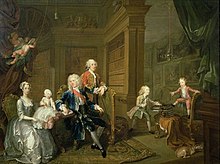George Cholmondeley, 3rd Earl of Cholmondeley
The Earl of Cholmondeley | |
|---|---|
 The Cholmondeley Family, William Hogarth (1732) | |
| Member of the British House of Commons | |
| In office 1724–1733 | |
| Preceded by | John Smith |
| Succeeded by | Sidney Beauclerk |
| Constituency | |
| Personal details | |
| Born | 2 January 1703 |
| Died | 10 June 1770 (aged 67) |
| Spouse |
Lady Mary Walpole (m. 1723) |
| Children | George, Viscount Malpas and Robert |
| Parent(s) | George Cholmondeley, 2nd Earl of Cholmondeley Elizabeth van Ruyterburgh |
| Military service | |
| Allegiance | Great Britain |
| Years of service | 1733–1760 |
George Cholmondeley, 3rd Earl of Cholmondeley KB, PC (/ˈtʃʌmli/ CHUM-lee; 2 January 1703 – 10 June 1770), styled as Viscount Malpas from 1725 to 1733, was a British Whig politician and nobleman who sat in the House of Commons from 1724 to 1733.
Life
[edit]Cholmondeley was the son of George Cholmondeley, 2nd Earl of Cholmondeley, and Elizabeth van Ruyterburgh (or Ruttenburg). He was elected to the House of Commons for East Looe in 1724, a seat he held until 1727, and then represented Windsor between 1727 and 1733, when he succeeded his father as third Earl of Cholmondeley and entered the House of Lords. He held office under his father-in-law Sir Robert Walpole as a Lord of the Admiralty from 1727 to 1729, as a Lord of the Treasury from 1735 to 1736 and as Chancellor of the Duchy of Lancaster from 1736 to 1743 (from 1742 to 1743 under the premiership of The Earl of Wilmington). From 1743 to 1744 he also served as Lord Privy Seal under Henry Pelham and was Joint Vice-Treasurer of Ireland between 1744 and 1757. In 1736, he was admitted to the Privy Council.[1]
Horace Walpole described him as "a vain and empty man, shoved up so high by his father-in-law, Sir Robert Walpole, and fallen into contempt and obscurity by his own extravagance and insufficiency."[2]
Apart from his political career, Lord Cholmondeley was also Lord Lieutenant of Cheshire and South Wales (less Denbighshire) from 1733 to 1760. He was promoted to colonel in 1745, major-general in 1755, and lieutenant-general in 1759. He was also involved in the charitable effort to create a home for foundlings in London, which was hoped would alleviate the problem of child abandonment. The home became known as the Foundling Hospital and Cholmondeley sat on its board as a founding Governor.
Private life
[edit]Lord Cholmondeley married Lady Mary Walpole, daughter of Prime Minister Robert Walpole, 1st Earl of Orford, in 1723. He died on 10 June 1770, aged 67. His eldest son George Cholmondeley, Viscount Malpas, predeceased him and he was succeeded in his titles by his grandson George, who was created Marquess of Cholmondeley in 1815. His second son Robert (1727–1804) began his career as a lieutenant in the 3rd Foot Guards but resigned after the Battle of Lauffeld in July 1747 and became a minister.[3] Robert was married to the socialite Mary Woffington.[4]
The actress Maria Nossiter was the daughter of Lord Cholmondeley's "favourite" housekeeper. Maria was educated, had money and enjoyed a successful, but brief, career. It is supposed that she was his daughter.[5]
References
[edit]- ^ "CHOLMONDELEY, Hon. George (1703-70)". History of Parliament Online. Retrieved 26 April 2019.
- ^ "Cholmondeley family". Elisa Rolle. Retrieved 17 May 2019.
- ^ Boswell, James (1950). London Journal 1762-1763 (2010 ed.). Entry for 17 December, note 10: Penguin. ISBN 978-0140436501.
{{cite book}}: CS1 maint: location (link) - ^ Highfill, Philip H.; Burnim, Kalman A.; Langhans, Edward A. (1993). A Biographical Dictionary of Actors, Actresses, Musicians, Dancers, Managers and Other Stage Personnel in London, 1660-1800. Vol. 16. Carbondale: Southern Illinois University Press. p. 226. ISBN 978-0-8093-1803-2.
- ^ "Nossiter, Maria Isabella (1735–1759), actress". Oxford Dictionary of National Biography (online ed.). Oxford University Press. 2004. doi:10.1093/ref:odnb/64355. Retrieved 2 November 2020. (Subscription or UK public library membership required.)
- 1703 births
- 1770 deaths
- British Army lieutenant generals
- British MPs 1722–1727
- British MPs 1727–1734
- Chancellors of the Duchy of Lancaster
- Knights Companion of the Order of the Bath
- Lord-lieutenants of Anglesey
- Lord-lieutenants of Caernarvonshire
- Lord-lieutenants of Cheshire
- Lord-lieutenants of Flintshire
- Lord-lieutenants of Merionethshire
- Lord-lieutenants of Montgomeryshire
- Members of the Parliament of Great Britain for English constituencies
- Members of the Privy Council of Great Britain
- Whig (British political party) MPs for English constituencies
- Members of the Parliament of Great Britain for constituencies in Cornwall
- Cholmondeley family
- Earls of Cholmondeley
- Lords of the Admiralty
